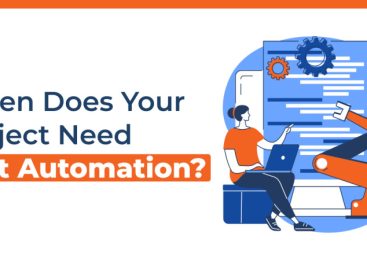- QATestLab Blog >
- Automated Testing >
- Initiating Automation Testing in the Digital Era: Decoding Its Significance and the Wisdom of Vendor Collaboration
Initiating Automation Testing in the Digital Era: Decoding Its Significance and the Wisdom of Vendor Collaboration

Nowadays, automation is swiftly transitioning from being a mere strategic edge to an unequivocal need. 87% of experienced QA experts, who have been doing automation testing for over five years, believe they can save at least 20% in costs. This accentuates the evident truth: a robust automation testing strategy, preferably steered by expert vendors, remains pivotal for any organization aiming for digital excellence.
Your decision to employ automation testing, combined with the choice of the right vendor, can profoundly influence your ability to stand out in this hyper-competitive digital realm. But even after recognizing its potential, ensuring an optimized and efficient testing mechanism that aligns with your organizational goals is challenging. A misstep or oversight in this direction can lead to operational hiccups, diminished user trust, and potential revenue setbacks.
As automation testing becomes more important, this article aims to explain how to start with it and how important it is to collaborate with independent vendors through it. Whether you are a well-established enterprise or a fledgling startup, gaining an in-depth understanding of the multifaceted aspects surrounding automation testing will position you to guarantee a top-tier user experience and operational reliability.
Automation Testing and Its Imperative Role
Automation testing, in essence, is the process of utilizing specialized software tools to conduct predefined test sequences to ensure a software’s quality. This automated approach is crafted to augment efficiency, repeatability, and accuracy in the testing processes. It is a sentinel, ensuring applications remain resilient against potential glitches and vulnerabilities.
On the other hand, automation testing is not merely about mechanizing repetitive tasks. It is about streamlining processes, fostering precision, and generating actionable insights. The complexities involved cover selecting the right testing tools, crafting robust testing scripts, and synchronizing them with agile development cycles. When executed adeptly, automation testing becomes an orchestra of synchronized instruments, ensuring software dances to the tunes of reliability and efficiency. Moreover, it is important to understand manual testing is a base for automation testing, and in an ideal world, automation and manual testing collaborate, complementing each other’s strengths.
But why is the act of automation testing paramount? Imagine deploying a digital product without rigorous quality checks. Automation testing serves as this strict and repeated check, ensuring your digital assets stand resilient in real-world scenarios, validating not only their functionality but also their performance, security, and compatibility. Furthermore, as digital ecosystems grow more intricate and intertwined, manual testing becomes time-consuming, prone to errors, and economically inefficient. Automation testing is a protector, ensuring comprehensive coverage, repeatability, and speed.
For a deeper perspective on the intricacies of automation testing, here is the list of its multifaceted benefits:
- Time efficiency. It dramatically reduces the testing cycle duration, enabling quicker product releases.
- Cost reduction. By minimizing human intervention, errors decrease, leading to significant savings in the long run.
- Scalability. Suitable for projects of varying scales, it ensures large codebases are tested comprehensively and smaller ones efficiently.
- Consistency. Offering repeatable testing processes ensures uniformity, reducing discrepancies and anomalies.
- Enhanced feedback. Immediate results provide developers timely feedback, expediting bug fixes and feature enhancements.

Switching to automated testing is about picking the right plan, tools, and team skills. If done correctly, it makes software better, delivers it quicker, and is worth the cost. To know more about its launch – stay focused on the following information.
Step-by-Step Guide on How to Start Automation Testing from Scratch
Starting automation testing from scratch might seem daunting, but with a structured approach, you can seamlessly integrate it into your development process. Before embarking on the automation journey, it is imperative to have a thorough understanding of the software under scrutiny. Delve into the software’s architecture, functionalities, and the potential areas where automation could be a silver bullet. The aim is to identify the tests that are repetitive, time-consuming, and prone to human error, making them ripe for automation. Here is a step-by-step guide to get you started.
1. Understand the basics.
Start by getting acquainted with the fundamental testing concepts, including the differences and applications of manual and automated testing.
2. Determine your goals.
Define what you aim to achieve with automation. Consider objectives like:
- Reducing manual testing efforts.
- Enhancing software quality.
- Achieving faster feedback loops.
3. Select the right tools
Depending on your software and needs, choose an appropriate tool. Popular options include:
- Selenium (Web applications)
- Appium (Mobile apps)
- TestNG (End-to-end testing)
4. Develop the necessary skills
Many automation tools require familiarity with programming. Get comfortable with the language your chosen tool supports, be it Java, Python, or others.
5. Start with a pilot project
Before full-scale automation, begin by automating a simple feature or functionality to understand the process.
6. Set up a Test environment
Create a dedicated environment for automation, ensuring it closely represents real-world user scenarios.
7. Write effective test scripts
As you draft scripts:
- Focus on user-centric scenarios.
- Clearly comment and document your logic.
- Regularly update as application features evolve.
8. Integrate with development cycles
Incorporate automation tests within your development cycle using tools like Jenkins or GitHub Actions.
9. Regular feedback and iteration
Consistently analyze test outcomes. Adjust based on findings and evolving user behaviors or platform updates.
10. Stay Updated and Collaborate
Join QA communities, attend training sessions, and consider the expertise vendors can bring to the table.
Automation testing is not just about writing scripts; it is about integrating quality assurance into the heart of development. While initiating automation testing in-house has its merits and offers a sense of control over processes, true excellence often requires external perspectives.
Collaborating with an independent vendor introduces fresh insights, access to specialized expertise, and the latest industry best practices. An external vendor can objectively evaluate your software, spot improvement areas, and enhance your automation strategy’s efficacy. So, while it is feasible to launch automation testing on your own for optimal results and to stay ahead of the curve, it is prudent to collaborate with a seasoned vendor, intertwining their knowledge with your vision.
Why Turning to a Vendor Is Strategic Brilliance In Test Automation?
Venturing into the domain of automation testing can be daunting, intensified by budget constraints, lack of in-house expertise, and the ever-evolving nature of digital platforms. Here is a full list of challenges of conducting automation testing without an independent vendor:
- Limited expertise. In-house teams might not always be updated with the latest trends, tools, or methodologies in automation testing. This gap in knowledge can lead to less effective test strategies and missed opportunities.
- Higher costs in the long run. While there might be an upfront cost saving, managing and maintaining an in-house automation infrastructure can become expensive in the long term, especially if issues arise or if there is a need for tool migration.
- Missed best practices. Vendors often have experience working with diverse clients and scenarios. This exposure equips them with best practices that might be missed when testing is conducted solely in-house.
- Delayed feedback loop. Without the streamlined processes and expertise of a vendor, the feedback loop in the testing phase can become prolonged, delaying product releases and updates.
- Risk management. In-house teams might not have strategies in place to mitigate risks associated with testing, potentially exposing the business to higher risks.
- Lack of continuous learning. Vendors often invest in training and development for their teams. In contrast, in-house teams might not have regular access to such learning opportunities, leading to stagnation in skills.

Therefore, conducting automation testing in-house without vendor assistance can diminish a product’s competitive edge due to outdated methodologies and overlooked flaws. Resource constraints and inability to scale might result in financial inefficiencies and delayed market releases. Overall, while in-house testing offers control, it may introduce significant challenges, risking the business’s reputation, growth, and profitability.
This is where expert vendors, like QATestLab, step into the spotlight. We recognize the paramount importance of automation testing in today’s digital ecosystem. Here is how our seasoned expertise serves as a boon for your business:
1. Customized solutions. Our dynamic, flexible approach ensures you get solutions tailored to your specific requirements, ensuring maximum ROI.
2. State-of-the-art tools. We harness the power of the industry’s leading automation testing tools, ensuring comprehensive coverage and optimal results.
3. Dedicated expertise. With a team of seasoned professionals, we guarantee your projects are in hands that understand the nuances of automation testing.
4. Cost efficiency. Collaborating with a vendor can prove more cost-effective in the long run, as it negates the need for substantial investments in tools, training, and continual upskilling.
Leveraging the expertise of a vendor can ensure that automation testing is comprehensive, up-to-date, and strategically aligned with business goals. Our automation testing strategies pinpointed the anomalies, leading to optimized site performance and a subsequent surge in user trust and revenue. To know more about our dedicated approaches and advantages of collaborating – dive deep into the transformative case study.

Dual Power of Testing: Automation Testing & QATestLab
Navigating the multifaceted world of quality assurance requires a keen sense of judgment—knowing when the power of automation serves best and recognizing instances when it may shine brighter with the vendor. Embarking on the testing odyssey demands a strategic calculus of potential risks and benefits, all while keeping a vigilant eye on the overarching project timeline. By adeptly managing resources, aligning with practical goals, and setting reasonable timelines, reliable vendors, as QATestLab ensures a methodical and potent approach to software testing every step of the way.
Engaging with a vendor not only provides access to specialized knowledge and tools but also introduces a fresh, objective perspective. Vendors, with their diverse client experiences, bring a repository of best practices, innovative solutions, and agility to adapt to the latest in the automation domain. More than mere service providers, they become strategic partners, working hand in hand with businesses to achieve shared goals.
As a trusted partner, we open doors to a reservoir of experienced QA professionals, delivering comprehensive testing solutions tailored to your needs. Engage with us and discover how our dedicated teams seamlessly infuse innovation into your digital journey, harmonize with advanced testing platforms, and pave the way for groundbreaking solutions.
Learn more from QATestLab
Related Posts:
- Automation Testing for Mobile Apps: Why It’s Essential and Our Key Services
- How One Bug Can Wreck Your Reputation — And How QA Prevents It
- QA Automation Tools: Low-Code, No-Code, or Coding-Based?
About Article Author
view more articles






